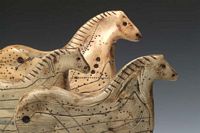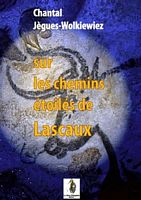| Gallery of
the Pleistocene Coalition Exploring a deeper ancestry through the arts |
Statement
of Purpose Pleistocene Coalition |
 ![tn_bilzingsleben-tony-mitton09[jfcrop].jpg](images/tn_bilzingsleben-tony-mitton09%5Bjfcrop%5D.jpg)
  |
![Winkler_M_Ancient Art & Modern Language Draft[4-24-10]_1_0001.jpg](images/Winkler_M_Ancient%20Art%20&%20Modern%20Language%20Draft%5B4-24-10%5D_1_0001.jpg)  Link to fiction set in Paleolithic times |

 ![tn_paleocameraPC1[fromMatt5-16-10]filesize-reduce-convert-to-grayscale[resofrom72to150_h4'']h700.jpg](images/tn_paleocameraPC1%5BfromMatt5-16-10%5Dfilesize-reduce-convert-to-grayscale%5Bresofrom72to150_h4%27%27%5Dh700.jpg) |
|
Dawn
of Purity
(from the Dawn of Purity Suite) ©1981 Poetry written & read by Pietro Di Giorgio Music, direction & recording, John Feliks Whitefella
Dreaming Music composed and performed by Amadeo Dujmovic. Original Wanjina sketches by Marina Lapadatovic. Until we are able to post the minimalist video, the two pictures alone here do not express the full subtle mood of this contemplative and transcendental piece. But please do be patient.   Two Wanjina group sketches by artist Marina Lapadatovic from the quasi-minimalist film and instrumental, Whitefella Dreaming, by Lapadatovic and composer/musician Amadeo Dujmovic, Croatia. Only a vision - that is what one must have. -Ernst Haas |
  Two pieces from the series Wanjina Watchers by Australian painter Gina Sinozich, 2009. Above, "Wanjina of Courage," below, "Astro Wanjina." Ms. Sinozich's is a rare story; a Croatian-born grandmother and refugee, she began painting at age 70 as a way to work through the traumatic pain she experienced in her life. Raised in totalitarian Europe Sinozich is an outsider who broke through the exclusivity of the modern art world and became an internationally-celebrated painter in only six years time. These paintings are two from a series of six which she did for Vesna Tenodi's DreamRaiser project. They are considered by curators, collectors, and critics as some of her best work. Sinozich's work clearly shows that true art is not simply a matter of training but of acting on one's inner experience and outer inspirations toward a vision that transcends the mundane world. Sinozich is now 84. Wanjinas, aside from the fact that their origins and original meanings are actually unknown, are Australian ancestral or creator beings from the Dreamtime. They have become of great interest recently to many non-Aboriginals inspired by this mysterious mythology. For more see Western civilization needs Wanjinas, below- Scenes from Sojournus Antiquitus - Sharlet Di Giorgio;
Detail, "Mastete ahs Kalucten," |
| QUESTS AND VISION The mission of the Pleistocene Coalition Gallery is to inspire a new exploration of prehistory, as well as the general question of what it means to be human, through active participation in the arts. Although the page is still in process, artists, poets, short story writers, musicians, instrumental composers, filmmakers, installation artists, interpretive dancers, sculptors, etc., are invited to submit their work to the Gallery. Abstract art and electronic music along with art exploring daily life in the past are all welcomed. Qualities that we are especially looking for is art with a great mood or that is thought-provoking, thrilling in a contemplative way, or inspirational. ___________________
If one would like to read about the Gallery idea which (like our newsletter) is meant to offer an alternative to the old science view of our ancestors as taught in classrooms and television today one can read the brief article, Launching the Gallery, in Pleistocene Coalition News #20, November-December 2012. ___________________ The Gallery is only now getting started and we are working through a few technical glitches (e.g., mp3 players not working in all browsers, page slow-loading, etc.) but decided to go forward with the launch anyway. We will tweak as we go. Visitors are welcome to write to the gallery director to mention if their browser is not reproducing correctly or how fast or slow the page is loading. One thing to mention up front is that the Gallery page will not be static but will change as it moves along. We are very excited about the Gallery project and look forward to what modern artists (or scientists who also have artistic interests) can add to our understanding of prehistory on a deeper and more meaningful level. As artists we all have stories to tell, places or ideas to explore. So, grab your paintbrush or go to the piano and maybe you can touch on something you never knew you had within you, or something you forgot you had within you. You may discover that science does not have the answers after all or that science has led you down a path that you felt obligated to follow against your natural inclination. It takes confidence and strength to stand up against a monopoly but that is what coalitions are for. Get back your confidence in the power of the arts. A new era of the artist with a broader reach is part of our vision; and it is only the beginning. The distinction between past, present, and future is only a stubbornly persistent illusion. - Albert Einstein - Western civilization needs Wanjinas A current controversy in arts related to prehistoric ancestors is that of the Wanjina rock art in Australia. In the current issue of Pleistocene Coalition News we feature another article in a series by Australian archaeologist, writer, and artist, Vesna Tenodi and her group of artists known as the DreamRaiser project. Wanjinas - although both their origins and early meaning are unknown - were inherited by many  Aboriginal groups as ancestor
creator beings. Since the earliest colonial records,
though, the Aborigines have mentioned that the Wanjina were already
there when
they arrived. The difficulty is that Tenodi's group which is inspired
by Wanjinas has had problems with the Australian government and various Aboriginal groups attempting
to censor their art as it is believed
that Wanjinas can only be an art of the Aboriginal people. The DreamRaiser project has encouraged many
non-Aboriginal people to learn about Wanjinas and use them as
inspiration for modern works of art. The quality of some of this art is
undeniable as demonstrated in the paintings by Gina Sinozich and Marina
Lapadatovic
featured above. Tenodi's own sculpture project (to the left and below)
was vandalized. Aboriginal groups as ancestor
creator beings. Since the earliest colonial records,
though, the Aborigines have mentioned that the Wanjina were already
there when
they arrived. The difficulty is that Tenodi's group which is inspired
by Wanjinas has had problems with the Australian government and various Aboriginal groups attempting
to censor their art as it is believed
that Wanjinas can only be an art of the Aboriginal people. The DreamRaiser project has encouraged many
non-Aboriginal people to learn about Wanjinas and use them as
inspiration for modern works of art. The quality of some of this art is
undeniable as demonstrated in the paintings by Gina Sinozich and Marina
Lapadatovic
featured above. Tenodi's own sculpture project (to the left and below)
was vandalized.Although both the Aboriginals and non-Aboriginal artists of the DreamRaiser project make their own good points which revolve around purported Aboriginal rights and artistic freedom, let's consider the issue in a slightly different light. [As an aside, the Gallery's director has a special interest in this subject having submitted a Wanjina thesis based on fossils of the Kimberley and nearby regions which was blocked by Australian scientists in the middle '90s. So, the interest is not only one of the art itself or of artistic freedom but also because of the way knowledge of Wanjina has been controlled by the anthropology community. The thesis was blocked because a reviewer said, "We already know all there is to know about Wanjinas."] To ask something of Aboriginals fighting against non-Aboriginal artists inspired by their artistic or religious heritage, Western society in its materialistic and headstrong culture needs every ounce of tempering it can get. Anyone who follows trends in cultural or environmental damage knows it is true that the Western  value
system needs to be
tempered. It would be of great benefit to the world if Aboriginals could see this larger picture and share the
positive vision of Wanjina of their own accord. Whatever modern
skeptics might say, these gods, if that is what they represent, and
myriad others have given humanity it's deepest
meanings during the past 5,000 years. And how far back in time do these concepts actually go? value
system needs to be
tempered. It would be of great benefit to the world if Aboriginals could see this larger picture and share the
positive vision of Wanjina of their own accord. Whatever modern
skeptics might say, these gods, if that is what they represent, and
myriad others have given humanity it's deepest
meanings during the past 5,000 years. And how far back in time do these concepts actually go?Most of the world's gods have been a part of the 'international' lexicon for hundreds of years and we have all been benefited by them in one way or another. At one time all of these gods were claimed to be the sole possession of particular ethnic groups. However, everything is interconnected. Apollo and Dionysus, for instance, are as important to the whole world today as they are to the modern Greeks. Jehovah or Yahweh is as important to the world as to those who live in Israel. Brahma, Vishnu, Shiva, are as important to the world as those who live in India. And contrary to what one might think it doesn't matter if someone has never heard of certain gods, or even if they care nothing about them, because humanity watches after its own including those who never think of such things as gods. If individual persons who don't believe in anything higher than themselves (which is an attitude increasing in our scientific world) weren't safely under the umbrella of a larger population that consistently does believe in something higher then our world would surely be in a worse place now. In other words, every individual's world benefits in some way from a transcendent vision somewhere in the world whether or not they know anything about any larger system or even imagine that they might be part of one. So, now a new and mysterious set of deities has made its appearance on the larger world stage. Like the gods of Olympus, these Wanjina are part of "our" heritage, not only the heritage of the Aboriginal people. Perhaps when the dust settles, artists in Tenodi's group or future artists will be inspired to study or reflect even more deeply on the idea of Wanjina, and progress just as European artists did who eventually, and undeniably, produced some of the greatest masterworks of humanity, works that inspire everyone with awe who can sense their beauty. It
is this belief in a power larger than myself
and other than myself which allows me to venture into the unknown and even the unknowable. - Maya Angelou - |
|
- Fiction set in
Paleolithic times
-
Above left: Tom Baldwin's book, The Evening and the Morning, is an entertaining fictional story based on the true story of Calico Early Man Site in California which was under the direction of Louis Leakey for 11 years. Along with Ice Age adventure the book includes Native American mysticism and a critical look at the scientific establishment. The setting takes place in two time periods simultaneously - the modern day and a much earlier age 185,000 years ago. Above right: Chantal Jègues-Wolkiewiez' book, sur les chemins étoilés de Lascaux (French), presents in a fictional setting her ideas about knowledge of astronomy, space and time at Lascaux Cave, c. 17,000 years ago. See Blog la table d’Hermes for a review and excerpts. Like in Baldwin’s book, Jègues-Wolkiewiez challenges the standard view of our ancestors by relating their abilities and sentiments as like our own rather than highly limited as taught by mainstream science.
INSPIRATIONAL QUOTES Encouraging creativity and getting involved in artistic community The
past remains integral to us all, individually and collectively. We must
concede the ancients their place...but their past is not simply back
there, in a separate and foreign country, it is assimilated in
ourselves and resurrected in an ever-changing present.
-David Lowenthal I desire no future that will break the ties with the past. -George Eliot The past empowers the present, and the sweeping footsteps leading to this present mark the pathways to the future. -Mary Catherine Bateson Creativity involves breaking out of established patterns in order to look at things in a different way. -Edward de Bono The creative person is both more primitive and more cultivated, more destructive and more constructive, a lot madder and a lot saner, than the average person. -Frank X Barron It is this belief in a power larger than myself and other than myself which allows me to venture into the unknown and even the unknowable. -Maya Angelou We need to know the cultural blinders that narrow our world view as well as the psychological blinders that narrow our view of our personal experience. -Christina Baldwin There is no agony like bearing an untold story inside of you. -Maya Angelou I believe that man's spirit deserves to be acknowledged, honored and celebrated. Perhaps our great cave artists understood the need for beautiful and hopeful thinking in action. -Philippe Benichou - PC artists involved with large scale and installation art -  Dragos Gheorghiu—is an experimental archaeologist, artist, pyro-technics expert, and professor of cultural anthropology and prehistoric art at National University of Arts, Bucharest, Romania. For many years, Gheorghiu has attempted to tackle the difficult subject of understanding the spirituality of prehistoric people through experimental archaeology. His work involves such universal and timeless experiences as human perceptions of landscape and the shared experience of fire, to name only two. Gheorghiu’s "Landart Transformations" (above) is a project at Monte Velho, Portugal; photo by Radu Damian. It is a visual representation of a prehistoric hill fort or castro. The idea is in part to help observers from a distance get an actual sense of place in three dimensions. Adapted from Pleistocene Coalition News #16 (March-April 2012).  Michael Winkler—Circle of Stones gallery installation at the Aademy of Fine Art, Poznan, Poland by conceptual artist Michael Winkler. See enlargement and details in right column. Spirit Island
Poetry written & read by Pietro Di Giorgio Music, direction & recording, John Feliks ©1981 This lake was once a valley and this small island, the pinnacle where decisions were made and announced Books did not tell me this or fragments of lore show me knowledge on hand-carved plates It was the magnetism of a hundred-thousand souls which hover in this spot It is the way the wind whispers to me and lifts my being It is the love I feel for island and lake, for the mountains and for life, and for myself when I am here ------ When I lose the sanity of my roots I shall come with my barnacled self to find the purity of holy places And the tears shall come without shame as I talk with smiling ghosts who tune me like a delicate stringed instrument who can once again hear the music of rocks and respond to the wisdom of water I always take ample supplies of wholeness with me when I leave my island For my spirit bridge is strong and my longing for its manna is a hunger which can never be satisfied Discovery in the Minimal Zone (a.k.a. "Phen
Hahten Speaks" from Selections
from the Permanent Library 2-9-85) John Feliks ©2001 MORE INSPIRATIONAL QUOTES Exerpts from John F. Kennedy's 1963 Amherst College speech about the importance of the arts in protecting society and as one of the most important endeavors to pursue for the future of mankind. "When power leads men towards arrogance, poetry reminds him of his limitations. When power narrows the areas of man's concern, poetry reminds him of the richness and diversity of his existence. When power corrupts, poetry cleanses. For art establishes the basic human truth which must serve as the touchstone of our judgment. The artist... becomes the last champion of the individual mind and sensibility against an intrusive society and an officious state. ...I see little of more importance to the future of our country and our civilization than full recognition of the place of the artist. ...We must never forget that art is not a form of propaganda; it is a form of truth." -John F. Kennedy ________________________+ Therefore
art means: you have to believe, to have faith, that is, cultivate
vision.
-Josef Albers |
![tn_paleocameraPC1[fromMatt5-16-10]filesize-reduce-convert-to-grayscale[resofrom72to150_h4'']h700.jpg](images/tn_paleocameraPC1%5BfromMatt5-16-10%5Dfilesize-reduce-convert-to-grayscale%5Bresofrom72to150_h4%27%27%5Dh700.jpg) ![tn_Horse projection-Matt'sField Reconstructions-page[htopsequ]crop.jpg](images/tn_Horse%20projection-Matt%27sField%20Reconstructions-page%5Bhtopsequ%5Dcrop.jpg) Above: Original depiction of paleo-camera theory by multimedia artist and theorist, Matt Gatton. Below: Photograph of a horse taken by Gatton with a lenseless camera obscura.  Above: Rendition by artist Laura Lyons of the Dorenberg skull believed to have been an example of Homo erectus in the Americas. The Dorenberg skull was found in the foundation of a house in the town of Puebla, Valsequillo region of Mexico, sometime prior to 1891. Experiencing a fate not unlike the famous Homo erectus fossils from Zhoukoudian China (collectively known as "Peking Man"), the Dorenberg fossil, which was housed in its own special case in the Leipzig Museum in Germany, was reported destroyed in an Allied bombing raid during World War II. This was only two years after the Zhoukoudian Homo erectus fossils disappeared. In this drawing, Lyons put a concerted effort into breaking out of the standard science portrayal of Homo erectus as brutish not-quite-there hominids and sought out their humanity. The picture was created for Pleistocene Coalition News Issue #2, November-December 2009. ![tn_bilzingsleben-tony-mitton09[jfcrop].jpg](images/tn_bilzingsleben-tony-mitton09%5Bjfcrop%5D.jpg)
![tn_peking-man_tony-mitton09[jfcrop1_2views-flipped].jpg](images/tn_peking-man_tony-mitton09%5Bjfcrop1_2views-flipped%5D.jpg) Above left: 400,000-year old Bilzingsleben bone artifacts depicted as being used in straight edge work; by Tom Mitton. Above right: Homo erectus composite. Tom Mitton is a Catia V5 technical designer in the automotive industry with additional artistic background in many visual arts and classical music.  Above: Polymer clay representations by Luann Udell inspired by the 17,000-year old paintings of Lascaux cave in France. Udell is an internationally-recognized commercial artist whose work is a reflection not only of Lascaux but also paintings from other caves and other Paleolithic art such as engravings. She developed an original polymer clay technique to imitate old ivory which has influenced other media artists as well. "When I visit a museum, I gaze eagerly upon the exhibits of ancient artifacts... Tenderly mounted under temples of glass, carefully labeled for display, they seem to speak to us in whispers of a time forgotten, of a people lost to us in antiquity. I create artifacts from such a lost culture, an imagined prehistory. I use these modern artifacts to retell ancient stories."  Above: Circle of
Stones gallery installation at the Aademy
of Fine Art, Poznan, Poland by
conceptual artist Michael
Winkler. The circle
of 26
stones (illuminated in blue light and based on the English alphabet)
with lines of reflective metal tape spelling out the word, "idea,"
rest on a bed of text-fragments
describing an
archeological discovery in central Poland. Although representing a
Neolithic rather than
Paleolithic site Winkler's experimental ideas draw attention to the
fact
that to truly understand our ancestors we must break away from
preconceptions and standard science thinking and try new approaches. In addition to being featured
in art journals such as Rampike Magazine
and in books such as Imagining Language
(Rasula & McCaffery, MIT Press, 1998), Winkler's
work is also part of the permanent collections in various art and
literary institutions in the U.S. and abroad such as the Museum of Contemporary Art, Chicago; the Library of The Museum of
Modern Art, New York; the Hans Sohm Archive at the
Staatsgalerie, Stuttgart,
Germany; the King Stephen Museum,
Hungary; and the National Institute of
Design, in India.
He is also Director of the Signalglyph Research Project exploring
connections between mathematics and ancient art. ![Winkler_M_Ancient Art & Modern Language Draft[4-24-10]_1_0001.jpg](images/Winkler_M_Ancient%20Art%20&%20Modern%20Language%20Draft%5B4-24-10%5D_1_0001.jpg)
Above: Original artistic representation of an Acheulian age stone glyph (c. 150,000-700,000 years old), Bhimbetka, India, by Michael Winkler. - Scenes from Sojournus Antiquitus -
  Above: Sharlet Di Giorgio; Two scenes form, "Mastete ahs Kalucten," an Upper Paleolithic migration story, Sojournus Antiquitus, 1996.  Above: Monte Nagler; One of 16 of Nagler's photographs projected as slides for the sequence, "Age of Desolation," about the hardship of an early age and the endurance of the human spirit, Sojournus Antiquitus, 1996. Nagler is an internationally-known award-winning fine art photographer and student of the pioneer of large-format nature photography, Ansel Adams. 
 Above: Three conté and pastel
drawings by Shekinah Errington from the "Eulogy for Quai ti Eumanita"
sequence about a
much-loved woman in an Upper Paleolithic clan, Sojournus Antiquitus,
1996.
Above: Three conté and pastel
drawings by Shekinah Errington from the "Eulogy for Quai ti Eumanita"
sequence about a
much-loved woman in an Upper Paleolithic clan, Sojournus Antiquitus,
1996.
  Two scenes of the
stage-front musicans and singers, |
If you have artwork including visual, installation art, music, poetry which is in line with tenets of the Pleistocene Coalition and would like to submit it for consideration in this gallery please contact the gallery director and webmaster, John Feliks (right-click)
- Prepare for a journey into a world you never knew existed -
© The Pleistocene Coalition 2009
This page last updated September 2, 2013

![Neanderthal.fern.fossil.leaning.on.rock[JoelWilson]81290003.CROPPED.gif](images/Neanderthal.fern.fossil.leaning.on.rock%5BJoelWilson%5D81290003.CROPPED.gif)





